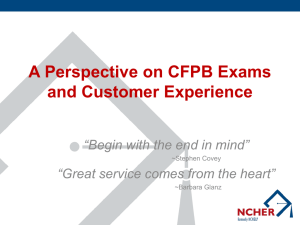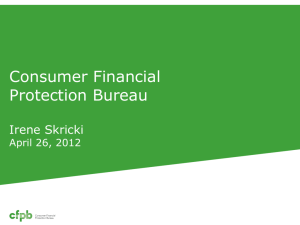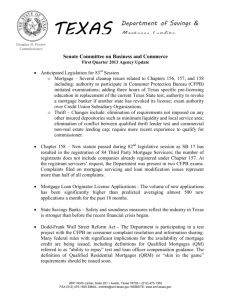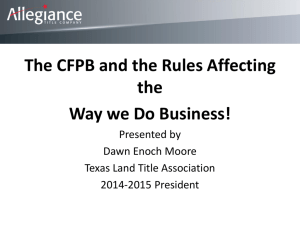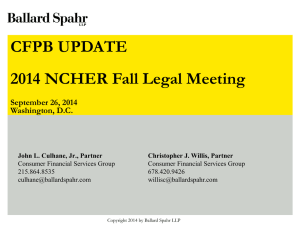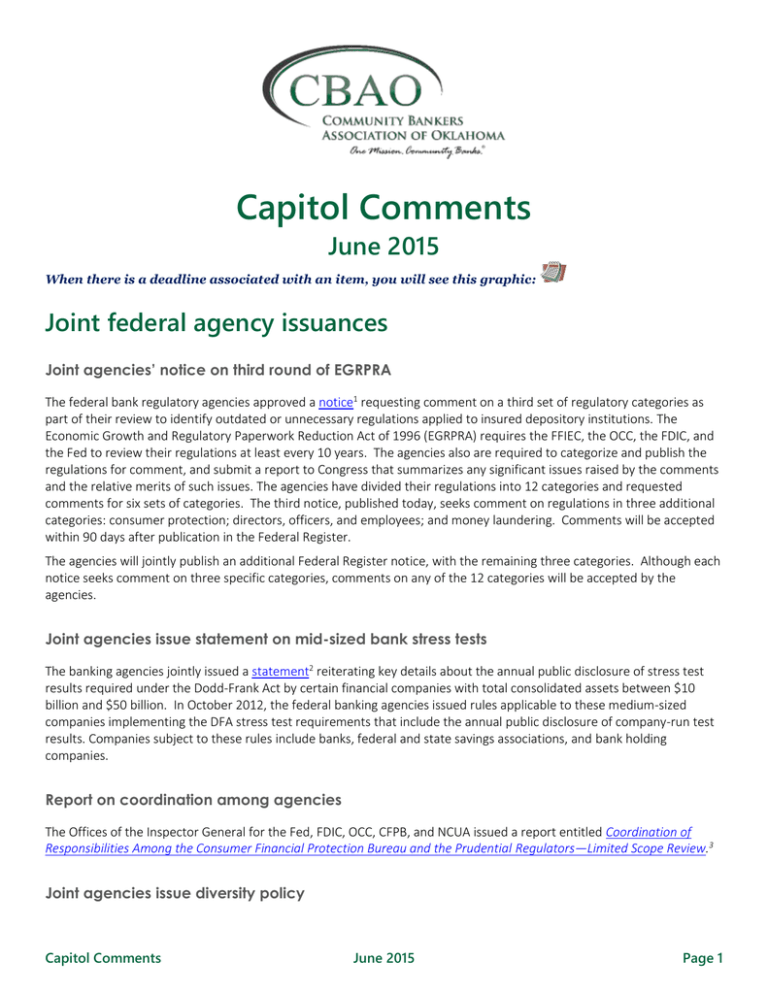
Capitol Comments
June 2015
When there is a deadline associated with an item, you will see this graphic:
Joint federal agency issuances
Joint agencies’ notice on third round of EGRPRA
The federal bank regulatory agencies approved a notice1 requesting comment on a third set of regulatory categories as
part of their review to identify outdated or unnecessary regulations applied to insured depository institutions. The
Economic Growth and Regulatory Paperwork Reduction Act of 1996 (EGRPRA) requires the FFIEC, the OCC, the FDIC, and
the Fed to review their regulations at least every 10 years. The agencies also are required to categorize and publish the
regulations for comment, and submit a report to Congress that summarizes any significant issues raised by the comments
and the relative merits of such issues. The agencies have divided their regulations into 12 categories and requested
comments for six sets of categories. The third notice, published today, seeks comment on regulations in three additional
categories: consumer protection; directors, officers, and employees; and money laundering. Comments will be accepted
within 90 days after publication in the Federal Register.
The agencies will jointly publish an additional Federal Register notice, with the remaining three categories. Although each
notice seeks comment on three specific categories, comments on any of the 12 categories will be accepted by the
agencies.
Joint agencies issue statement on mid-sized bank stress tests
The banking agencies jointly issued a statement2 reiterating key details about the annual public disclosure of stress test
results required under the Dodd-Frank Act by certain financial companies with total consolidated assets between $10
billion and $50 billion. In October 2012, the federal banking agencies issued rules applicable to these medium-sized
companies implementing the DFA stress test requirements that include the annual public disclosure of company-run test
results. Companies subject to these rules include banks, federal and state savings associations, and bank holding
companies.
Report on coordination among agencies
The Offices of the Inspector General for the Fed, FDIC, OCC, CFPB, and NCUA issued a report entitled Coordination of
Responsibilities Among the Consumer Financial Protection Bureau and the Prudential Regulators—Limited Scope Review.3
Joint agencies issue diversity policy
Capitol Comments
June 2015
Page 1
Six federal agencies issued a final interagency policy statement establishing joint standards4 for assessing the diversity
policies and practices of the entities they regulate.
Section 342 of the Dodd-Frank Act required the Fed, the CFPB, the FDIC, the NCUA, the OCC, and the SEC to each
establish an Office of Minority and Women Inclusion (OMWI) to be responsible for all matters relating to diversity in
management, employment, and business activities. The Dodd-Frank Act also instructed each OMWI director to develop
standards for assessing the diversity policies and practices of the agencies' regulated entities.
Comment: The standards recognize that not all regulated entities can be treated the same. The policy statement provides:
‘The Agencies recognize that each entity is unique with respect to characteristics such as its size, location, and structure.
When drafting these standards, the Agencies focused primarily on institutions with more than 100 employees. The Agencies
know that institutions that are small or located in remote areas face different challenges and have different options available
to them compared to entities that are larger or located in more urban areas. The Agencies encourage each entity to use
these standards in a manner appropriate to its unique characteristics.’’ Each set of standards begins with this: “In a manner
reflective of the individual entity’s size and other characteristics….” The standards begin on the seventh page of the
document we linked to above.
The document also contains this very important statement: “This document is a general statement of policy under the
Administrative Procedure Act, 5 U.S.C. 553. It does not create new legal obligations. Use of the Standards by a regulated
entity is voluntary. The Agencies will not use their examination or supervisory processes in connection with these Standards.”
CFPB actions
CFPB proposes to delay TRID effective date
On Wednesday, June 17th, CFPB Director Richard Cordray issued the following statement on the Truth in Lending/RESPA
integrated disclosures (TRID):
“The CFPB will be issuing a proposed amendment to delay the effective date of the Know Before You Owe rule until
October 1, 2015. We made this decision to correct an administrative error that we just discovered in meeting the
requirements under federal law, which would have delayed the effective date of the rule by two weeks. We further
believe that the additional time included in the proposed effective date would better accommodate the interests of the
many consumers and providers whose families will be busy with the transition to the new school year at that time.”
The public will have an opportunity to comment on this proposal and a final decision is expected shortly thereafter.
Comment: This is very good news. Now, everyone needs to keep working hard! The effective date will be here before we
know it.
CFPB blog
Ally settlement administrator will contact eligible borrowers soon (Spanish version)
Sound off on student loan servicing
Consumer advisory: Don’t be misled by reverse mortgage advertising
Know Before You Owe: You’ll get 3 days to review your mortgage closing documents
Working to improve the financial lives of people with disabilities
Save the date: Join us for the Summer Consumer Advisory Board meeting in Omaha, Neb.
Planning for financial decisions as you age
Capitol Comments
June 2015
Page 2
Spring 2015 rulemaking agenda
Here’s why childhood is an important time to learn about money
Comment: Click here to see all CFPB blogs.
CFPB publishes Spring 2015 rulemaking agenda
The CFPB released an overview of its major rule-making initiatives. The agenda includes rulemaking in pre-rule, proposed
rule, final rule, long-term, and completed stages. They are:
Updates to HMDA (The CFPB is finalizing a proposed rule.5 They expect to release it in late summer.)
TILA/RESPA Integrated Disclosures (TRID) (As we now all know, this rule6 will be implemented on October 1. In
February, the CFPB issued a small follow-up rule7 to provide technical corrections, address provision related to
new construction loans on the Loan Estimate form, and relax certain timing requirements. The CFPB prepared
guides and materials for industry8 and consumers.9)
Follow-up on other mortgage rules (The CFPB is finalizing their proposal10 to modify requirements for small
creditors in rural or underserved areas. They plan to issue a final rule in the fall of 2015. Also finalizing a proposed
mortgage servicing rule11 that would affect disclosures, early intervention, and loss mitigation. The final rule
should be issued in spring 2016.)
Prepaid financial products (They are finalizing a proposed rule12 that would create comprehensive consumer
protections for prepaid financial products. It will likely be issued in early 2016.)
Payday, auto title, and certain other loans (The CFPB issued an outline of proposals13 it is considering and will
likely issue a Notice of Proposed Rulemaking later this year.)
Overdrafts (The CFPB previously issued a white paper14 and a report.15 It is conducting additional research and
assessing whether rulemaking is warranted.)
Larger participants (This has to do with nonbank entities.)
Debt collection (Last year, the CFPB issued an Advanced Notice of Proposed Rulemaking16 and received over
23,000 comments. They are surveying consumers about their experiences and engaging in consumer testing to
determine what information consumers need.)
Arbitration (CFPB issued a preliminary report17 in 2013 and a report to Congress18 in March 2015. They are
evaluating feedback and considering rules.)
Comment: With all the discussion of TRID, let’s not forget that there are a number other areas the CFPB is working on that
will affect community banks. And let’s hope the CFPB further enlarges the rural definition to enhance mortgage lending in
rural areas and promote competitive equality among similarly situated mortgage lenders.
CFPB bulletin on financial decisions as consumers age
The CFPB worked with the SEC to create a Consumer Advisory and Investor Bulletin19 to help consumers plan for a time
when diminished capacity or illness leaves them unable to manage their money and property. The advisory has advice on
planning for the future, getting documents in order, and watching out for financial exploitation.
CFPB “will be sensitive to” good faith TRID implementation efforts
The CFPB, in a letter20 from Director Cordray to members of Congress, announced that it would be “sensitive to the
progress made by those entities that have been squarely focused on making good faith efforts to come into compliance
with the [TILA-RESPA Integrated Disclosure] rule on time.”
Capitol Comments
June 2015
Page 3
Comment: This letter was issued before the CFPB delayed TRID until October 1. We do not know whether the CFPB will send
Congress another letter like this regarding supervision after the new effective date. The letter to Congress was not the “hold
harmless” period many industry leaders had called for. The CFPB did not clarify the meaning of “sensitive” or elaborate on
what would constitute “good-faith” efforts.
CFPB clarifies misunderstandings about updated TRID disclosures
A CFPB announcement21 attempted to “clarify misunderstandings” regarding the limited circumstances in which the TRID
rules require a revised Closing Disclosure triggering a new waiting period. In a fact sheet, the CFPB outlined the following
three changes that would require revised disclosures and a new three-day review period:
Increasing the annual percentage rate (APR) by more than 1/8 of a percentage point for a fixed-rate loan or 1/4 of
a percentage point for an adjustable-rate loan (decreasing the interest rate or fees doesn’t cause a delay).
The addition of a prepayment penalty.
Changes in the loan product, from a fixed-rate to an adjustable-rate loan, for example.
Comment: If any of the three conditions are met, the lender would have to provide the borrower with a revised Closing
Statement and reset the three-day review period mandated by the TILA-RESPA Integrated Disclosure rule. Other issues
addressed up until closing including the correction of errors or most changes to a payment amount would not trigger a
revised Closing Statement. Note: The first bullet point may be an error; the law actually speaks of irregular loans.
CFPB launches financial well-being initiative for those with disabilities
The CFPB announced22 the launch of the Reach Outcomes. Achieve Dreams. Succeed. (ROADS) to Financial Independence
initiative, which is aimed at improving the financial well-being and economic security of individuals with disabilities. The
initiative, which is piloting with local partners in six communities across the country, will integrate financial counseling
with employment, independent living, and other support services that are being provided to individuals with disabilities.
CFPB issues consumer advisory on reverse mortgage advertising
The CFPB looked closely at many ads for reverse mortgages and found incomplete and inaccurate statements used to
describe the loans. In addition, the CFPB found that most of the important loan requirements were often buried in fine
print if they were even mentioned at all. Because the CFPB believes these advertisements may leave older homeowners
with the false impression that reverse mortgage loans are a risk-free solution to financial gaps in retirement, it issued a
consumer advisory23 on reverse mortgage advertising.
Comment: I am not sure what the CFPB means when they say that the ads are incomplete. It would be impossible to include
everything about a reverse mortgage in an advertisement. Maybe certain assertions were inaccurate because of missing
information. Safeguards currently exist to make sure that consumers are not uninformed or misinformed—counseling is
required for those seeking a reverse mortgage (it is the only financial product that requires counseling). It seems that the
counselors would fill in the gaps where the ads were incomplete. The CFPB additionally said that some ads contained
inaccurate statements. That is problematic. We assume the CFPB contacted the advertisers and “encouraged” them to fix
their inaccurate ads.
CFPB finalizes rules for large non-bank auto-finance companies
The CFPB published a rule24 today that will allow it to supervise larger nonbank auto finance companies for the first time.
The CFPB also released the examination procedures that examiners will use to ensure that auto finance companies are
following the law. Press release.25
Capitol Comments
June 2015
Page 4
Comment: Although this doesn’t apply to banks, if your bank has an automobile finance operation, you may want to review
the rules and exam procedures when accessing your practices.
FDIC actions
FDIC issues state profiles for First Quarter of 2015
To retrieve a state profile, click here26 then select a state from either the map or the list below the map.
FDIC Summary of Deposits Survey
The Summary of Deposits is the annual survey of branch office deposits as of June 30 for all FDIC-insured institutions,
including insured U.S. branches of foreign banks. All institutions with branch offices are required to submit the survey;
institutions with only a main office are exempt. All survey responses are required by July 31, 2015. No filing extensions will
be granted. FIL-24-201527
FDIC issues Spring 2015 Consumer News
Teaching Young People About Money: Tips for Parents and Caregivers
For All Ages: Teaching Young People About Money
For Pre-K to Grade 2: Earning and Saving Right From the Start
For Grades 3-5: The Creation of a Comparison Shopper
For Grades 6-8: Tips for the Teen Years…and Beyond
For Grades 9-12: It’s Like ... How to Speak to High School Kids About Money. Totally!
For College Students: Passing Big Tests on Money Management
FDIC Publishes New Resources for Teaching Young People About Money
How to Learn More
Also Inside
Computer Security Tips for Bank Customers: A Basic Checklist
Changes Could Help Boost Credit Scores
A New Way to Save for Children With Disabilities
Comment: Great information on teaching kids about money. Also a checklist you might distribute to your customers with tips
on staying safe online.
OCC actions
OCC supervisory focus through September 30, 2015
The OCC’s Committee on Bank Supervision (CBS) annually develops an operating plan that sets forth the agency’s broad
supervision priorities and objectives. The agency’s fiscal year (FY) commenced on October 1, 2014, and concludes
September 30, 2015. The operating plan provides the foundation for developing individual bank supervisory strategies
and policy initiatives. CBS managers use this plan to guide their supervisory priorities, planning, and resource allocations
Capitol Comments
June 2015
Page 5
for FY 2015. This document provides a mid-cycle status report on some of the key accomplishments to date and priorities
for the remainder of the year.
The supervisory focus for the second half of FY 2015 centers on the following:
• Strategic planning and execution: OCC supervisory staff will focus on the adequacy of strategic, capital, and succession
planning processes in light of assumed risks and planned initiatives. Staff will assess whether banks’ plans are realistic and
appropriate risk management processes are established and followed.
• Corporate governance: OCC supervisory staff will reinforce the importance of sound corporate governance appropriately
calibrated to the size and complexity of the individual bank.
• Stress testing: OCC supervisory staff will review the appropriateness of Dodd–Frank Act stress testing processes
conducted by banks with more than $10 billion in assets.
• Operational risk: OCC supervisory staff will assess the operational risk present in banks. Staff will focus on all phases of
risk management, including planning, due diligence, internal controls, reporting, and ongoing monitoring.
• Cyber threats: OCC supervisory staff will review banks’ programs for assessing the evolving threat environment and
continuously adjusting controls, as well as for robust vulnerability assessments and timely correction, access
management, and incident response programs.
• Loan underwriting: OCC supervisory staff will evaluate the underwriting practices for new or renewed loans in banks,
with specific emphasis on leveraged loan, indirect auto, and energy portfolios for slippage in structure and terms.
• Interest rate risk: OCC supervisory staff will focus on IRR measurement processes to ensure that management properly
assesses banks’ vulnerability to changes in interest rates and implements measurement tools to monitor and control this
risk. Staff will focus on banks’ ability to accurately identify and quantify IRR in both assets and liabilities (e.g., investment
securities and non-maturity deposits) under varying model scenarios.
• Compliance: OCC supervisory staff will assess effectiveness in complying with consumer laws, regulations, and guidance.
Staff reviews will include assessments of banks’ processes to analyze, manage, and control risks posed by new products
and services and emerging technologies.
Comment: This summer, the OCC will release the supervisory priorities that form the basis for developing supervisory
strategies for FY 2016.
OCC improves online access to business combination corporate applications
The OCC today announced improved access to information and public comments regarding business combination
corporate applications submitted by national banks and federal savings associations. NR 2015-8328
Comptroller speaks on how supervision has evolved
Comptroller of the Currency Thomas J. Curry spoke29 on June 9, 2015, at the Prudential Bank Regulation Conference in
Washington, D.C. about how the OCC’s approach to prudential supervision has evolved in the days since the financial
crisis.
OCC issues Residential Real Estate Lending booklet
The OCC issued the “Residential Real Estate Lending30” booklet of the Comptroller’s Handbook. This revised booklet
replaces the “Real Estate Loans” booklet issued in March 1990 (and examination procedures issued in March 1998). The
revised booklet also replaces section 212, “One- to Four-Family Residential Real Estate Lending,” issued in February 2011
as part of the former OTS Examination Handbook for the examination of federal savings associations.
Comment: Nothing in this booklet should be interpreted as changing existing OCC policy.
Capitol Comments
June 2015
Page 6
Federal Reserve actions
Fed updates Commercial Bank Examination Manual
The Federal Reserve recently performed the semiannual update of the Commercial Bank Examination Manual.31 The
manual presents examination objectives and procedures that Federal Reserve System examiners follow in evaluating the
safety and soundness of state member banks. This is intended as guidance for planning and conducting bank
examinations.
Fed issues 101st Annual Report
The Fed issued its 101st Annual Report32 (2014) covering Board and System operations and activities during calendar-year
2014
Fed issues alert on expired Protecting Tenants at Foreclosure Act
The Fed issued CA 15-433, which states in pertinent part:
The Protecting Tenants at Foreclosure Act of 2009 (PTFA), which originally became effective on May 20, 2009, expired on
December 31, 2014. Accordingly, examiners in the Federal Reserve System should no longer evaluate institutions’
compliance with the PTFA…While the Board does not at this time anticipate conducting examinations for compliance with
state laws, supervisory and examination staff may consider an institution’s policies and procedures for state law
compliance in assessing the effectiveness of its compliance management programs.
The Board notes that the guidance in SR 12-5/CA 12-3 and the attached “Policy Statement on Rental of Residential Other
Real Estate Owned (OREO) Properties” remains in effect and, in accordance with that guidance, banking organizations’
residential property rental activities are expected to comply with all applicable federal, state, and local laws and
regulations.
Comment: If your examiners are still citing the PTFA, point them to CA 15-4. It is difficult to keep up with all the moving
pieces in bank regulation.
Fed issues FAQs on Volcker rule
The Fed, working closely with the other agencies charged with implementing the requirements of the so-called Volcker
rule, including the OCC, FDIC, SEC, and the Commodity Futures Trading Commission, issued frequently asked questions34
that apply to banking entities for which the Board has jurisdiction under the Volcker rule. The questions were developed
by staffs of the listed agencies and substantively identical versions will appear on the public websites of each agency.
Fed issues June Beige Book
Reports from the twelve Federal Reserve Districts suggest overall economic activity expanded during the reporting period
from early April to late May. Activity in the Richmond, Chicago, Minneapolis, and San Francisco Districts was characterized
as growing at a moderate pace, while the New York, Philadelphia, and St. Louis Districts cited modest growth. Contacts in
the Boston District reported mixed conditions, and the Cleveland and Kansas City Districts indicated a slight pace of
expansion. Compared to the previous report, the pace of growth slowed slightly in the Dallas District but held steady in
Capitol Comments
June 2015
Page 7
the Atlanta District. Outlooks among respondents were generally optimistic, with growth expected to continue at a
modest to moderate pace in several districts. June Beige Book.35
FedFocus
FedFocus36 is the source for the latest Federal Reserve Financial Services news. Each edition keeps you informed about
hot topics in the industry, as well as provides insight into the value of Federal Reserve Financial Services. In this month’s
edition:
Greatest hits: Commercial Bank sings the praises of FedACH® Services
Have you ever wondered how U.S. currency makes its way into circulation? Watch this!
Are you taking advantage of our top-notch tools and training?
FedFlash
FedFlash37 is your source for the latest Federal Reserve Financial Services operational news. Each bulletin keeps you
informed of issues critical to your day-to-day operations, providing you with National and District updates regarding the
Fed’s products and services, processes, technical protocols and contact information. In this month’s edition:
Check/Check 21 Services
Commercial check and ACH posting rule changes
Freeze period for Check Services
Change in process for handling items drawn on retired routing numbers
Check Adjustments Tip: Check Adjustments Automated Status Report at your fingertips
Spotlight on Train the Trainer webinar
Upcoming Check Services operations freeze
Canadian item cash letter deposit reminders
Federal Reserve Banks to publish new FedReceipt®RTNs
FedACH® Services
FedACH Feature: The FedACH Risk® RDFI Alert Service can provide a basic type of ACH positive pay service to
business customers
Commercial check and ACH posting rule changes
FedCash® Services
Have you ever wondered how U.S. currency makes its way into circulation? Watch this!
Other federal action and news
Supreme Court decision on junior liens in Chapter 7 cases
Bank of America, N.A v. Caulkett:38 Respondent debtors each filed for Chapter 7 bankruptcy, and each owned a house
encumbered with a senior mortgage lien and a junior mortgage lien, the latter held by petitioner bank. Because the
Capitol Comments
June 2015
Page 8
amount owed on each senior mortgage is greater than each house’s current market value, the bank would receive
nothing if the properties were sold today. The junior mortgage liens were thus wholly underwater. The debtors sought to
void their junior mortgage liens under §506 of the Bankruptcy Code, which provides, “To the extent that a lien secures a
claim against the debtor that is not an allowed secured claim, such lien is void.” 11 U. S. C. §506(d). In each case, the
Bankruptcy Court granted the motion, and both the District Court and the Eleventh Circuit affirmed.
The Supreme Court held: A debtor in a Chapter 7 bankruptcy proceeding may not void a junior mortgage lien under
§506(d) when the debt owed on a senior mortgage lien exceeds the current value of the collateral if the creditor’s claim is
both secured by a lien and allowed under §502 of the Bankruptcy Code.
FTC report to the CFPB on Regs. E, M, and Z enforcement
The staff of the FTC has provided its 2014 Annual Financial Acts Enforcement Report to the Consumer Financial Protection
Bureau39 on enforcement and related activities regarding Reg. Z, Reg. M, and Reg. E.
The report addresses, among other things, the FTC’s enforcement actions related to non-mortgage credit (including
automobile purchases and financing, and payday lending), mortgage loan advertising, and forensic audit scams;
rulemaking, research, and policy development related to truth in lending; and consumer and business education
regarding truth in lending requirements. It also addresses consumer leasing enforcement actions, as well as negative
option and other cases involving electronic fund transfers.
Treasury issues risk assessments
The U.S. Department of the Treasury today issued the National Money Laundering Risk Assessment and the National
Terrorist Financing Risk Assessment. The purpose of these assessments is to help the public and private sectors
understand the money laundering and terrorist financing methods used in the United States, the risks that these activities
pose to the U.S. financial system and national security, and the status of current efforts to combat these methods. In
doing so, these assessments enable the U.S. Government and financial institutions to more effectively detect and combat
illicit finance.
For the 2015 National Money Laundering Risk Assessment, click here.40
For the 2015 National Terrorist Financing Risk Assessment, click here.41
FATF issues AML standards
The Financial Action Task Force issued a document entitled: International Standards on Combating Money Laundering and
the Financing of Terrorism & Proliferation – The FATF Recommendations
Comment: The FATF is an independent inter-governmental body that develops and promotes policies to protect the global
financial system against money laundering, terrorist financing and the financing of proliferation of weapons of mass
destruction. The FATF Recommendations are recognized as the global anti-money laundering and counter-terrorist financing
standard.
FCC adopts exempts bank fraud notices from robocall protection rule
Capitol Comments
June 2015
Page 9
The FCC adopted a proposal42 to protect consumers against unwanted robocalls and spam texts. In a package of
declaratory rulings, the Commission affirmed consumers’ rights to control the calls they receive. As part of this package,
the Commission also made clear that telephone companies face no legal barriers to allowing consumers to choose to use
robocall-blocking technology. The rulings were informed by thousands of consumer complaints about robocalls the FCC
receives each month. Complaints related to unwanted calls are the largest category of complaints received by the
Commission, numbering more than 215,000 in 2014.
Publications, articles, reports, studies, testimony &
speeches
Publications, articles, reports, studies, testimony and speeches by the federal banking agencies—that formerly would
have appeared here—are now found in each agency’s specific section above. In future issues, this section will contain
materials from entities (both regulatory and private) that don’t have their own section above. There is nothing to report
this month.
Selected federal rules proposed
Proposed rules are included only when it is imperative that community banks comment.
COMMENTS
CLOSE
07.02.2015
SUMMARY OF PROPOSED RULE
Enhancements to Federal Reserve Bank Same-Day ACH Service, Request for Comments. The Board of Governors (Board) is
requesting comment on enhancements that the Federal Reserve Banks (Reserve Banks) are considering to their current sameday automated clearing house (ACH) service. The enhancements would require receiving depository financial institutions (RDFIs)
to participate in the service and originating depository financial institutions (ODFIs) to pay a fee to RDFIs for each same-day ACH
forward transaction. The Board believes that these changes may have a significant longer-run effect on the nation's payment
system. Interested persons may express their views in writing to the Board, by any of the methods indicated below.
Selected federal rules adopted since last issue
Not all final rules are included. Only rules affecting community banks are reported, but we make no guarantees that these
are all the final rules your bank needs to know about.
EFFECTIVE
DATE:
SUMMARY OF FINAL RULE:
Good News! We didn’t identify any federal rules adopted since our April edition that warranted reporting,
Capitol Comments
June 2015
Page 10
Selected federal rules - upcoming effective dates
Not all final rules are included. Only rules affecting community banks are reported, but we make no guarantees that these
are all the final rules your bank needs to know about.
EFFECTIVE
DATE:
SUMMARY OF FINAL RULE:
10.01.2015
CFPB: Final integrated Mortgage Disclosures under the RESPA (Reg. X) and the Truth In Lending Act (Reg. Z)43 Notice of final
rule and official interpretations. The CFPB amended Reg. X and Reg. Z to establish new disclosure requirements and forms in
Regulation Z for most closed-end consumer credit transactions secured by real property. In addition to combining the existing
disclosure requirements and implementing new requirements imposed by the Dodd-Frank Act, the final rule provides extensive
guidance regarding compliance with those requirements. CFPB blog on the disclosure.
10.01.2015
CFPB: Amendments to the 2013 Integrated Mortgage Disclosures Rule under Reg. X and Reg. Z and the Loan Originator
Rule under Reg. Z44 (80 FR 876745) Notice of final rule and official interpretations. This rule amending the integrated mortgage
rule extends the timing requirement for revised disclosures when consumers lock a rate or extend a rate lock after the Loan
Estimate is provided and permits certain language related to construction loans for transactions involving new construction on
the Loan Estimate. This rule also amends the 2013 Loan Originator Final Rule to provide for placement of the NMLSR ID on the
integrated disclosures. Additionally, the CFPB made non-substantive corrections, including citation and cross-reference updates
and wording changes for clarification purposes, to various provisions of Regulations X and Z as amended or adopted by the 2013
TILA-RESPA Final Rule. CFPB blog on the disclosure
It is a certainty that the TRID rules will be delayed, so we’ve changed the dates from August 1, 2015 to October 1, 2015,
based on CFPB Director Cordray’s statement.
Selected federal rules – past effective dates
Our list of effective dates of past final federal rules is limited to approximately 12 months.
EFFECTIVE
DATE:
05.01.2015
02.23.2015
SUMMARY OF FINAL RULE:
The Board adopted final amendments46 to the Small Bank Holding Company Policy Statement (Regulation Y, Appendix C) (Policy
Statement) that: (i) raise from $500 million to $1 billion the asset threshold to qualify for the Policy Statement; and (ii) expand
the scope of companies eligible under the Policy Statement to include savings and loan holding companies. The Board is also
adopting final conforming revisions to Regulation Y and Regulation LL, the Board’s regulations governing the operations and
activities of bank holding companies and savings and loan holding companies, respectively, and Regulation Q, the Board’s
regulatory capital rules. Specifically, the Proposed Rule would allow bank holding companies and savings and loan holding
companies with less than $1 billion in total consolidated assets to qualify under the Policy Statement, provided the holding
companies also comply with three qualitative requirements (Qualitative Requirements). Previously, only bank holding companies
with less than $500 million in total consolidated assets that complied with the Qualitative Requirements could qualify under the
Policy Statement. The Board issued the Policy Statement in 1980 to facilitate the transfer of ownership of small community-based
banks in a manner consistent with bank safety and soundness. The Board adopted the Policy Statement to permit the formation
and expansion of small bank holding companies with debt levels that are higher than typically permitted for larger bank holding
companies.
Credit risk retention.47 The OCC, Board, FDIC, Commission, FHFA, and HUD adopted a joint final rule to implement the credit risk
retention requirements of Section 15 of the Securities and Exchange Act of 1934, as added by section 941 of the Dodd-Frank Act.
Section 15G generally requires the securitizer of asset-backed securities to retain not less than 5 percent of the credit risk of the
assets collateralizing the asset-backed securities. Section 15G includes a variety of exemptions from these requirements,
including an exemption for asset-backed securities that are collateralized exclusively by residential mortgages that qualify as
“qualified residential mortgages,” as such term is defined by the agencies by rule.
Capitol Comments
June 2015
Page 11
01.01.2015
Reg. Z annual threshold adjustments (CARD ACT, HOEPA and ATR/QM). The CFPB issued a final rule48 amending the regulatory
text and official interpretations for Regulation Z. The CFPB must calculate annually the dollar amounts for several provisions in
Regulation Z. This final rule reviews the dollar amounts for provisions implementing amendments to TILA under the CARD Act,
HOEPA, and the Dodd-Frank Act.
01.01.2015
Reg. Z adjustment to asset-size exemption threshold.49 The CFPB amended the official commentary that interprets the
requirements of Reg. Z to reflect a change in the asset size threshold for certain creditors to qualify for an exemption to the
requirement to establish an escrow account for a HPML based on the annual percentage change in the average of the CPI-W for
the 12-month period ending in November. The exemption threshold is adjusted to increase to $2.060 billion from $2.028 billion.
Therefore, creditors with assets of $2.060 billion or less as of December 31, 2014, are exempt, if other requirements of
Regulation Z also are met, from establishing escrow accounts for higher-priced mortgage loans in 2015. The adjustment to the
escrows exemption asset-size threshold will also increase a similar threshold for small-creditor portfolio and balloon-payment
qualified mortgages. Balloon-payment qualified mortgages that satisfy all applicable criteria, including being made by creditors
that do not exceed the asset-size threshold, are also excepted from the prohibition on balloon payments for high-cost
mortgages.
01.01.2015
HMDA adjustment to asset-size exemption threshold.50 The CFPB issued a final rule amending the official commentary that
interprets the requirements of HMDA to reflect a change in the asset-size exemption threshold for banks, savings associations,
and credit unions based on the annual percentage change in the average of the CPI-W. The exemption threshold is adjusted to
increase to $44 million from $43 million. Therefore, banks, savings associations, and credit unions with assets of $44 million or
less as of December 31, 2014, are exempt from collecting data in 2015.
01.01.2015
Basel III.51 The FDIC has issued an interim final rule that revises the existing capital rules to incorporate certain revisions to the
Basel capital framework, including Basel III and other elements. The interim final rule strengthens the definition of regulatory
capital, increases risk-based capital requirements, and makes selected changes to the calculation of risk-weighted assets. Basel III
Framework is effective 1/1/2014 for large, internationally active insured depository institutions and is effective 1/1/2015 for all
other insured depository institutions, subject to a transition period. Standardized Approach is effective 1/1/2015 for all insured
depository institutions Applicability: The rule applies to all FDIC-supervised banks and savings associations. Publication Reference:
FIL-31-2013 dated 7/9/2013. Also See: New Capital Rule-Community Bank Guide attached to FIL-13-2013 Informational video
and expanded summary on the interim final rule at: www.fdic.gov/regulations/capital. FDIC Press Release PR-60-2013 dated
7/9/2013
11.30.2014
Servicemembers Civil Relief Act Notice Disclosure, Form HUD-9207052, expires. This form is required to notify homeowners in
default of their mortgage of the foreclosure rights of servicemembers and their dependents under SCRA. Presumably, a new
form will be available in time.
11.17.2014
The CFPB amended subpart B of Regulation E, which implements the Electronic Fund Transfer Act, and the official interpretation
to the regulation (Remittance Rule). This final rule53 extends a temporary provision that permits insured institutions to estimate
certain pricing disclosures pursuant to section 1073 of the Dodd-Frank Wall Street Reform and Consumer Protection Act. Absent
further action by the Bureau, that exception would have expired on July 21, 2015. Based on a determination that the termination
of the exception would negatively affect the ability of insured institutions to send remittance transfers, the Bureau is extending
the temporary exception by five years from July 21, 2015, to July 21, 2020. The Bureau is also making several clarifications and
technical corrections to the regulation and commentary.
11.10.2014
CFPB finalized a rule54 to allow financial institutions to use an alternative delivery method to provide annual privacy notices
through posting the annual notices on their websites if they meet certain conditions. Specifically, financial institutions may use
the alternative delivery method for annual privacy notices if:
no opt-out rights are triggered by the financial institution’s information sharing practices under GLBA or FCRA section 603,
and opt-out notices required by FCRA section 624 have previously been provided, if applicable, or the annual privacy notice
is not the only notice provided to satisfy those requirements;
the information included in the privacy notice has not changed since the customer received the previous notice; and
the financial institution uses the model form provided in Regulation P as its annual privacy notice
11.03.2014
The CFPB amended55 certain mortgage rules issued in 2013. The final rule provides an alternative small servicer definition for
nonprofit entities that meet certain requirements and amends the existing exemption from the ability-to-repay rule for nonprofit
entities that meet certain requirements. The final rule also provides a limited, post-consummation cure mechanism for loans that
exceed the points and fees limit for qualified mortgages, but that meet the other requirements for being a qualified mortgage at
consummation.
07.01.2014
Foreign Tax Compliance Act. FATCA targets noncompliance by U.S. citizens of tax obligations using foreign accounts. FATCA seeks
information on accounts held in other countries by U.S. taxpayers. Governments can either permit their Foreign Financial
Capitol Comments
June 2015
Page 12
Institutions to entire into agreements with the IRS to provide information or they can enter into one of two alternative Model
Intergovernmental Agreements with the U.S. Treasury’s FATCA page56. List of FATCA agreements in effect.57
Common words, phrases, and acronyms
APOR
“Average Prime Offer Rates” are
derived from average interest rates,
points, and other pricing terms offered
by a representative sample of creditors
for mortgage transactions that have
low-risk pricing characteristics.
ATM
Automated Teller Machine
CARD Act
Credit Card Accountability
Responsibility and Disclosure Act of
2009
CFPB
Consumer Financial Protection
Bureau
CFR
Code of Federal Regulations.
Codification of rules and regulations of
federal agencies.
FR
Federal Register. U.S. government
daily publication that contains
proposed and final administrative
regulations of federal agencies.
FRB (or Fed)
Federal Reserve Board
FSOC
Financial Stability Oversight Council
FTC
Federal Trade Commission
GAO
Government Accountability Office
HARP
Home Affordable Refinance Program
HAMP
Home Affordable Modification
Program
HMDA
Home Mortgage Disclosure Act
HOEPA
Home Ownership and Equity
Protections Act of 1994
CRA
Community Reinvestment Act. This
Act is designed to encourage loans in
all segments of communities.
CRE
Commercial Real Estate
CSBS
Conference of State Bank Supervisors
HPML
Higher Priced Mortgage Loan
Currency Transaction Report. Filed for
each deposit, withdrawal, exchange of
currency that involves a transaction in
currency of more than $10,000.
HUD
CTR
U.S. Department of Housing and
Urban Development
IRS
Internal Revenue Service
Dodd-Frank Act
The Dodd–Frank Wall Street Reform
and Consumer Protection Act
MLO
Mortgage Loan Originator
DOJ
Department of Justice
MOU
Memorandum of Understanding
FDIC
Federal Deposit Insurance
Corporation
NFIP
National Flood Insurance Program.
U.S. government program to allow the
purchase of flood insurance from the
government.
NMLS
National Mortgage Licensing System
OCC
Office of the Comptroller of the
Currency
OFAC
Office of Foreign Asset Control
OREO
Other Real Estate Owned
QRM
Qualified Residential Mortgage
Reg.
Abbreviation for “Regulation” – A
federal regulation. These are found in
the CFR.
Reg. B
Equal Credit Opportunity
Reg. C
Home Mortgage Disclosure
EFTA
Electronic Fund Transfer Act
Federal bank regulatory agencies
FDIC, FRB, and OCC
Federal financial institution
regulatory agencies
CFPB, FDIC, FRB, NCUA, and OCC
FEMA
Federal Emergency Management
Agency
FFIEC
Federal Financial Institutions
Examination Council
FHFA
Federal Housing Finance Agency
FHA
Federal Housing Administration
FinCEN
Financial Crime Enforcement Network
Capitol Comments
June 2015
Page 13
Reg. DD
Truth in Savings
Reg. E
Electronic Fund Transfers
Reg. G
S.A.F.E. Mortgage Licensing Act
Reg. P
Privacy of Consumer Financial
Information
Reg. X
Real Estate Settlement Procedures Act
Reg. Z
Truth in Lending
RESPA
Real Estate Settlement Procedures Act
SAR
Suspicious Activity Report – Report
financial institutions file with the U.S.
government (FinCEN) regarding
activity that may be criminal in nature.
SDN
Specially Designated National
TILA
Truth in Lending Act
TIN
Tax Identification Number
Treasury
U.S. Department of Treasury
This publication is designed to provide accurate and authoritative information in regard to the subject matter covered. It is provided with the
understanding that the publisher is not engaged in the rendering of legal, accounting or other professional advice - from a Declaration of Principles
adopted by the American Bar Association and a Committee of Publishers and Associations; All rights reserved; Shannon Phillips Jr., Editor;
Oklahoma Edition, copyrighted by Craig Buford, CBAO President and CEO.
Capitol Comments
June 2015
Craig Buford, CAE
President and CEO
Community Bankers Association of Oklahoma
4101 Perimeter Center Drive, Suite 107
Oklahoma City, OK 73112
Office: 405-524-4122
1
http://www.federalreserve.gov/newsevents/press/other/20150529b.htm
2
http://www.federalreserve.gov/newsevents/press/bcreg/bcreg20150602a1.pdf
3
http://oig.federalreserve.gov/reports/cfpb-responsibilities-coordination-review-jun2015.pdf
4
http://www.gpo.gov/fdsys/pkg/FR-2015-06-10/pdf/2015-14126.pdf
5
https://www.federalregister.gov/articles/2014/08/29/2014-18353/home-mortgage-disclosure-regulation-c
6
https://www.federalregister.gov/articles/2013/12/31/2013-28210/integrated-mortgage-disclosures-under-the-real-estate-settlement-proceduresact-regulation-x-and-the
7
https://www.federalregister.gov/articles/2015/02/19/2015-01321/amendments-to-the-2013-integrated-mortgage-disclosures-rule-under-the-realestate-settlement
8
http://www.consumerfinance.gov/regulatory-implementation/tila-respa/
9
http://files.consumerfinance.gov/f/201503_cfpb_your-home-loan-toolkit-web.pdf
10
https://www.federalregister.gov/articles/2015/02/11/2015-02125/amendments-relating-to-small-creditors-and-rural-or-underserved-areasunder-the-truth-in-lending-act
11
https://www.federalregister.gov/articles/2014/12/15/2014-28167/amendments-to-the-2013-mortgage-rules-under-the-real-estate-settlementprocedures-act-regulation-x
12
https://www.federalregister.gov/articles/2014/12/23/2014-27286/prepaid-accounts-under-the-electronic-fund-transfer-act-regulation-e-and-thetruth-in-lending-act
13
http://files.consumerfinance.gov/f/201503_cfpb_outline-of-the-proposals-from-small-business-review-panel.pdf
Capitol Comments
June 2015
Page 14
14
http://files.consumerfinance.gov/f/201306_cfpb_whitepaper_overdraft-practices.pdf
15
http://files.consumerfinance.gov/f/201407_cfpb_report_data-point_overdrafts.pdf
16
https://www.federalregister.gov/articles/2013/11/12/2013-26875/debt-collection-regulation-f
17
http://files.consumerfinance.gov/f/201312_cfpb_arbitration-study-preliminary-results.pdf
18
http://files.consumerfinance.gov/f/201503_cfpb_arbitration-study-report-to-congress-2015.pdf
19
http://www.consumerfinance.gov/f/201505_cfpb_consumer-advisory-and-investor-bulletin-planning-for-diminished-capacity-and-illness.pdf
20
http://www.housingwire.com/ext/resources/files/Editorial/Trey-Files/20150603-RC-to-Donnelly-and-Scott-et-al-re-TILA-RESPA.pdf
21
http://www.consumerfinance.gov/blog/know-before-you-owe-youll-get-3-days-to-review-your-mortgage-closing-documents/
22
http://www.consumerfinance.gov/newsroom/cfpb-launches-financial-well-being-initiative-targeted-to-people-with-disabilities/
23
http://www.consumerfinance.gov/blog/consumer-advisory-dont-be-misled-by-reverse-mortgage-advertising/
24
http://files.consumerfinance.gov/f/201506_cfpb_defining-larger-participants-of-the-automobile-financing-market-and-defining-certainautomobile-leasing-activity-as-a-financial-product-or-service.pdf
25
http://files.consumerfinance.gov/f/201506_cfpb_defining-larger-participants-of-the-automobile-financing-market-and-defining-certainautomobile-leasing-activity-as-a-financial-product-or-service.pdf
26
https://www.fdic.gov/bank/analytical/stateprofile/
27
https://www.fdic.gov/news/news/financial/2015/fil15024.html
28
http://www.occ.gov/news-issuances/news-releases/2015/nr-occ-2015-83.html
29
http://www.occ.gov/news-issuances/speeches/2015/pub-speech-2015-82.pdf
30
http://www.occ.gov/news-issuances/bulletins/2015/bulletin-2015-29.html
31
http://www.federalreserve.gov/boarddocs/supmanual/supervision_cbem.htm
32
http://www.federalreserve.gov/publications/annual-report/files/2014-annual-report.pdf
33
http://www.federalreserve.gov/bankinforeg/caletters/caltr1504.htm
34
http://www.federalreserve.gov/bankinforeg/volcker-rule/faq.htm
35
http://www.federalreserve.gov/monetarypolicy/beigebook/beigebook201506.htm?full_report
36
https://www.frbservices.org/fedfocus/index.html
37
https://www.frbservices.org/fedflash/
38
http://www.supremecourt.gov/opinions/14pdf/13-1421_p8k0.pdf
39
https://www.ftc.gov/system/files/documents/reports/federal-trade-commission-enforcement-activities-related-compliance-regulation-z-truthlending-act/150609staffrptcfpbtila.pdf?utm_source=govdelivery
40
http://www.treasury.gov/resource-center/terrorist-illicitfinance/Documents/National%20Money%20Laundering%20Risk%20Assessment%20%E2%80%93%2006-12-2015.pdf
41
http://www.treasury.gov/resource-center/terrorist-illicitfinance/Documents/National%20Terrorist%20Financing%20Risk%20Assessment%20%E2%80%93%2006-12-2015.pdf
42
https://www.fcc.gov/document/fcc-strengthens-consumer-protections-against-unwanted-calls-and-texts
Capitol Comments
June 2015
Page 15
43https://www.federalregister.gov/articles/2013/12/31/2013-28210/integrated-mortgage-disclosures-under-the-real-estate-settlement-procedures-
act-regulation-x-and-the
44https://www.federalregister.gov/articles/2013/12/31/2013-28210/integrated-mortgage-disclosures-under-the-real-estate-settlement-procedures-
act-regulation-x-and-the
45
https://www.federalregister.gov/articles/2015/02/19/2015-01321/amendments-to-the-2013-integrated-mortgage-disclosures-rule-under-thereal-estate-settlement
46
http://www.gpo.gov/fdsys/pkg/FR-2015-04-15/pdf/2015-08513.pdf
47
https://www.federalregister.gov/articles/2014/12/24/2014-29256/credit-risk-retention
48https://www.federalregister.gov/articles/2014/08/15/2014-18838/truth-in-lending-regulation-z-annual-threshold-adjustments-card-act-hoepa-
and-atrqm#h-4
49
https://www.federalregister.gov/articles/2014/12/29/2014-30405/truth-in-lending-act-regulation-z-adjustment-to-asset-size-exemption-threshold
50
https://www.federalregister.gov/articles/2014/12/29/2014-30404/home-mortgage-disclosure-regulation-c-adjustment-to-asset-size-exemptionthreshold
51http://www.fdic.gov/news/news/financial/2013/fil13031.html
52http://portal.hud.gov/hudportal/documents/huddoc?id=92070.pdf
53https://www.federalregister.gov/articles/2014/09/18/2014-20681/electronic-fund-transfers-regulation-e
54https://www.federalregister.gov/articles/2014/10/28/2014-25299/amendment-to-the-annual-privacy-notice-requirement-under-the-gramm-
leach-bliley-act-regulation-p
55https://www.federalregister.gov/articles/2014/11/03/2014-25503/amendments-to-the-2013-mortgage-rules-under-the-truth-in-lending-act-
regulation-z#h-4
56
http://www.treasury.gov/resource-center/tax-policy/treaties/Pages/FATCA.aspx
57
http://www.treasury.gov/resource-center/tax-policy/treaties/Pages/FATCA-Archive.aspx
Capitol Comments
June 2015
Page 16


